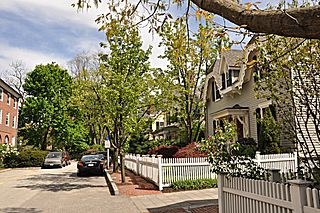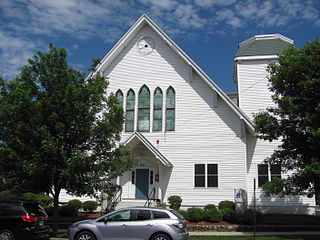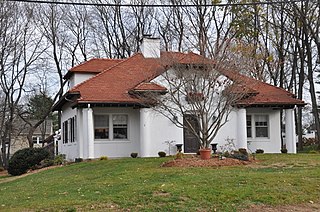
Harvard Yard is the oldest and among the most prominent parts of the campus of Harvard University in Cambridge, Massachusetts. The yard has a historic center and modern crossroads and contains most of the freshman dormitories, Harvard's most important libraries, Memorial Church, several classroom and departmental buildings, and the offices of senior university officials, including the President of Harvard University.

The National Register of Historic Places is a United States federal official list of places and sites considered worthy of preservation. In the state of Massachusetts, there are over 4,300 listings, representing about 5% of all NRHP listings nationwide and the second-most of any U.S. state, behind only New York. Listings appear in all 14 Massachusetts counties.

Spring Hill is a ridge in the central part of the city of Somerville, Massachusetts, United States, and the residential neighborhood that sits atop it. It runs northwest to southeast, roughly bounded by Highland Avenue, Somerville Avenue, Elm Street, and Willow Avenue. Summer Street runs along the hill's crest.

This is a list of sites listed on the National Register of Historic Places in Cambridge, Massachusetts. This is intended to be a complete list of the properties and districts on the National Register of Historic Places in Cambridge, Massachusetts, United States. Latitude and longitude coordinates are provided for many National Register properties and districts; these locations may be seen together in an online map.

The Wheelockville District is an historic district located at Mendon and Henry streets in the village of Wheelockville in Uxbridge, Massachusetts. It encompasses a collection of modest Federal and Greek Revival period worker housing, built primarily to house families of workers at the nearby Waucantuck Mill Complex. The oldest houses in the area were built c. 1825–35, and include cottages built by the mill owners. A second phase of growth between about 1860 and 1885 resulted in the construction of a number of buildings with vernacular Victorian elements, as well as the somewhat more ornate Italianate Wheelock House at 173 Mendon Street, which was built for a manager at another Uxbridge mill. The district runs roughly along Mendon Street from Hecla Street to the junction of Mendon and Henry Streets, and then along those two streets for about six houses.

The Ash Street Historic District Cambridge, Massachusetts is a residential historic district on Ash Street and Ash Street Place between Brattle and Mount Auburn Streets in Cambridge, Massachusetts, off Brattle Street just west of Harvard Square. The district consists of ten well-preserved houses, most of which were built between 1850 and 1890. The district was listed on the National Register of Historic Places in 1982.

The Berkeley Street Historic District is a historic district on Berkeley Street and Berkeley Place in Cambridge, Massachusetts. It encompasses a neighborhood containing one of the greatest concentrations of fine Italianate and Second Empire houses in the city. It was listed on the National Register of Historic Places in 1982, with a substantial increase in 1986.

The East Cambridge Historic District encompasses the historic center of East Cambridge, Massachusetts. It includes the major buildings that were built to house county services for Middlesex County beginning in the 1810s, and a cluster of largely vernacular Greek Revival worker housing located west of the county complex on Otis, Thorndike, Spring, and Sciarappa Streets. The district was listed on the National Register of Historic Places in 1983.

The Follen Street Historic District is a historic district in Cambridge, Massachusetts, just northwest of the Cambridge Common. Follen Street is a quiet residential street, isolated from through streets by large masonry buildings that front on Waterford Street and Garden Street. All but three of the houses on the street were built no later than 1900, and show a remarkable quality of workmanship, despite being diverse in their styles. A number of the houses are specifically associated with educators, including a number of Harvard University professors. The Edwin Abbot House at 1 Follen Street is now the main building of the Longy School of Music of Bard College, and is separately listed on the National Register. Other houses listed separately include the Theodore W. Richards House at 15 Follen, the Second Waterhouse House at 9 Follen, and 10 Follen Street.

The Garfield Street Historic District is a historic district on Garfield Street between Massachusetts Ave. and Oxford Street in Cambridge, Massachusetts. The district encompasses a unified residential area developed between 1885 and 1891. Garfield Street was laid out in 1883, and all but three of the houses built before 1891 still stand on the street. The houses were built by different developers, and most were architect designed, and thus vary stylistically. The streetview, however, is unified by uniform lot sizes, house heights, and setbacks. Queen Anne styling predominates, with a variety of massing and roof lines; many houses have turrets and/or wraparound porches typical of that style.

The Old Cambridge Historic District is a historic district encompassing a residential neighborhood of Cambridge, Massachusetts that dates to colonial times. It is located just west of Harvard Square, and includes all of the properties on Brattle Street west of Mason Street to Fresh Pond Parkway, all of the properties on Mason Street and Elmwood Avenue, and nearby properties on Craigie Street. The district includes five National Historic Landmarks: Elmwood, the Reginald A. Daly House, the Oliver Hastings House, the Mary Fiske Stoughton House, and the Longfellow House–Washington's Headquarters National Historic Site, as well as several other houses listed separately on the National Register. The district follows the general route of the Watertown Path, an early colonial road that supposedly followed a Native American trail. This portion of the way became known as Tory Row during the American Revolution, because many of the fine mansions lining it were owned by Loyalists. In the 19th and early 20th centuries it continued by a fashionable location, and now features a number of architecturally significant buildings. It includes 215 contributing buildings and one other contributing sites over an area of 52 acres (21 ha). One included building is the Cambridge Historical Society's offices, which are in the NRHP-listed Hooper-Lee Nichols House, located at 159 Brattle Street.

The Valentine Soap Workers Cottages are a pair of adjacent historic houses in Cambridge, Massachusetts, that are listed on the National Register of Historic Places.

The Salem–Auburn Streets Historic District is a residential historic district at Salem and Auburn Streets in Cambridge, Massachusetts. The district includes a collection of houses that is among the oldest in the Cambridgeport section of the city, and includes most of the houses on two blocks of these streets. The district was added to the National Register of Historic Places in 1982.

The Lower Highlands Historic District encompasses one of the oldest residential areas of Fall River, Massachusetts. The district is roughly bounded by Cherry, Main, Winter, and Bank Streets, and is located just east of the Downtown Fall River Historic District and directly south of the Highlands Historic District. This area was settled by 1810, has architecture tracing the city's growth as a major industrial center. The historic district was added to the National Register of Historic Places in 1984.

The First Unitarian Church is a historic former church building in Stoneham, Massachusetts. One of Stoneham's more stylish Gothic Revival buildings, the Stick style wood structure was built in 1869 for a Unitarian congregation that was organized in 1858. The building was listed on the National Register of Historic Places in 1984, and included in the Central Square Historic District in 1990. It presently houses the local Community Access Television organization.

The Charles Street Workers' Housing Historic District is a residential historic district at 128–144 Charles Street in Waltham, Massachusetts. It consists of four houses on a single city block, all of which are well-preserved vernacular worker houses built in 1865. They are representative of the city's growth of the period, and typify housing built for the city's laborers. The district was listed on the National Register of Historic Places in 1989.

The Elizabeth Boit House is a historic house at 127 Chestnut Street in Wakefield, Massachusetts.

The House at 88 Prospect Street in Wakefield, Massachusetts is one of three houses in the family compound of Elizabeth Boit. Built in 1913, the compound of which this house is a part is the only estate of one of Wakefield's major industrial figures to survive. The house was listed on the National Register of Historic Places in 1989.

The House at 90 Prospect Street in Wakefield, Massachusetts, is one of three houses in the family compound of Elizabeth Boit. Built in 1913, the compound of which this house is a part is the only estate of one of Wakefield's major industrial figures to survive. The house was listed on the National Register of Historic Places in 1989.

Hartwell and Richardson was a Boston, Massachusetts architectural firm established in 1881, by Henry Walker Hartwell (1833–1919) and William Cummings Richardson (1854–1935). The firm contributed significantly to the current building stock and architecture of the greater Boston area. Many of its buildings are listed on the National Register of Historic Places.
























